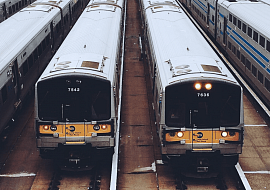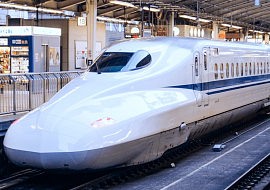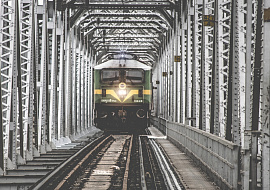CBTC Has Proven Its Ultimate Performance in Railway Signaling. What to Expect Next?
Sufficient time has elapsed to state the ultimate reliability and operative advantage of Communications-Based Train Control (CBTC) over conventional railway signaling systems. Despite lots of features being equal for both systems, utilization of CBTC allows to overcome the speed supervision limits, enhance the rollback protection, simplify maintenance, optimize energy consumption, and – most important – maximize the throughput of the rail network. Thus, it’s reasonable that having similar safety characteristics for both, more and more companies around the world decide on the rail line updates utilizing CBTC technology.
Conventional signaling is an ingenious invention of its time, but now there are few products released specially for this direction. Meanwhile, the CBTC market is growing at a considerable rate and expects a CAGR of 5.5% over the next 5 years, which is remarkable for the rail signaling market in general. The share of CBTC products prevails over the other rail signaling solutions, such as PTC, ATP, and ATS, although all these systems are interconnected. What is so special about CBTC and is it worth directing development efforts to it? Let’s find out in this article.
Railway Signaling: When Do We Utilize CBTC?
Today, CBTC is implemented for those rail lines where it’s critical to maximize the throughput. It potentially involves most of the urban rails, such as rapid transit, commuter rail, and, of course, high-speed metros. Conventional railway signaling simply can’t provide the required accuracy of tracking train location at such high speeds. Despite all the pros, the wide adoption of CBTC is limited through a range of factors, the main of which is financial.
Surely, its adoption is expected to increase naturally with the growing demand for rail transportation. Despite all its advantages, CBTC is not implemented for low-loaded rail sectors, and for most freight rail as well. Thus, the developers of solutions for CBTC are capable of accelerating this process by utilizing rail innovation for making the implementation and the use of CBTC more affordable.
CBTC Architecture for Railway Signaling
The reliability and performance of the CBTC system strongly rely on well-coordinated interactions between all its components to provide train detection and operational control via wireless protocols. Certainly, CBTC systems must be designed under strict industry standards to be implemented on the rail network. But there is a range of varieties in its design, which affects the flexibility, availability, maintainability, and other properties of the system, as well as its lifecycle.
CBTC is a complex system that requires the following components for its implementation:
%201.png)
- Wayside equipment. CBTC allows for getting rid of most of the wayside equipment. Track-side controllers, transponders, and radio towers have to be incredibly reliable to withstand harsh environmental conditions.
- Carborne equipment. Onboard Automatic Train Protection (ATP) / Automatic Train Operation (ATO) controls the movement of the train by getting instructions from the control unit. It requires the introduction of reliable train-wayside communication, as well as tools for network management.
- Train-to-wayside wireless communication. Any solution must be developed to comply with maximum network delay at less than 500 mc, time for wireless transmission at less than 50 mc, as well as packet loss at less than 0.1%. Thus, it’s critical to consider all the factors that influence connectivity.
- Interlocking equipment interaction. Information transmitted between the train and the ground also reaches the interlocking controller for it to correctly perform the functions of moving switches and signals at the station.
- Dispatch Center interaction. Automatic Train Supervision (ATS) provides train identification, tracking, and routing, which is critical to observe train movements from a back office.
While upgrading the existing rail lines, CBTC signaling systems are not built from scratch, but harmoniously overlay on the conventional block signaling system. That is, the existing onboard equipment can remain in use and communicate with CBTC via the existing protocols. Interlocking, which is executed following a certain logic, has also been tied with the CBTC system.
Looking to the future, we find it essential to consider the significant digital potential of the CBTC system, that is, its connectivity. For instance, connect the asset monitoring system to CBTC to provide it with immediate information if something fails.
Main Directions of CBTC Development for Railway Signaling
Although CBTCs are in many ways superior to predecessors, they also have weak points that drive the development of such systems.
Whenever updating, it requires re-testing the safety-critical functions for both the system as a whole and its components. It touches both onboard and wayside devices. For instance, when adjusting the track maps, we must confirm these updates would not affect the other functions, such as brake management, door control, berthing, and so on. That’s why every CBTC system requires continuous testing support to comply with all the authority requirements, such as CENELEC, IEEE, and AREMA.
Railway CBTC solution providers develop their protocols to provide train-to-ground communication, but they mostly lack a cybersecurity component. Like any digital communication, rail communication must be securely protected to prevent a man-in-the-middle attack, rogue access point, denial of service, and many more. The latest generations of CBTC systems use Enterprise IOT technology to improve performance, which puts security at even greater risk, subjecting to vulnerabilities in authentication, encryption, and transmission of safety-critical data. Moreover, other railway systems are then connected to CBTC units, such as Traffic Management, or Supervision, which brings additional hazards to these systems too.
To protect the connection, Key Management Systems are created to distribute the cryptographic keys between railway devices, that is, it validates their security. However, while developing any rail cybersecurity solution, it is crucial to ensure that it does not increase the latency within the entire system.
The crucial feature of the CBTC system might be compromised too and require overpayments if pay little attention to the environmental research on the specific location. For instance, GPS can’t operate in tunnels, which requires more sophisticated infrastructure to provide seamless CBTC operation. Also, it can suffer from signal issues, such as electromagnetic interference, weak signal, a saturation of the communication environment, or risk of mixing frequencies with the LTE range. Thus, there is room for improvement, that can be occupied by innovations. For instance, ultra-wideband radio, 5G, or many more technologies can contribute to more powerful and invulnerable communication within the CBTC system.
Despite CBTC standards being developed by several organizations, if a system by a specific vendor is deployed at the rail line, the line becomes tied to this vendor throughout further maintenance. Since the expected extension of CBTC standards, such solutions are likely to provide more interoperability in the future. This may become a new step closer to simplifying the CBTC infrastructure as well. Thus, CBTCs are likely to increase their modularity in the future. Although it requires less equipment to implement Communication-Based Train Control in comparison with conventional signaling, the infrastructure remains complicated, which requires deployment and maintenance issues.
Should We Focus on Driverless Trains?
CBTC implementation doesn’t require the driver, since all the train control operations are automated. Technically it allows for the ultimate grade of automation, which is called GoA4. Autonomous trains are faster acquired by manufacturing companies, that implement such trains to carry materials to places of production. So far, some economic and organizational factors slow down autonomous trains' global adoption for passenger transportation. However, the enhancement of safety levels is a weighty argument in favor of autonomous passenger trains since they eliminate human errors.
Further developments of CBTC systems, need to be targeted at additional safety improvements. For instance, advanced obstacle detection tools are required within driverless train operations. Automation should be performed in coherence with advanced rail monitoring, onboard sensors, and networks developed with fail-safety in mind, to provide the ultimate safety level. All these subsystems should be tied-in with the CBTC unit.
Conclusions
As we can see, the potential for CBTC systems enhancements is abound. It touches its various features such as connectivity, safety, interoperability, and so on. Thus, when developing CBTC solutions, we recommend considering the following factors.
- Despite the relatively closed railway signaling market, we can expect the trend of increased compatibility of CBTC systems, since their growing standardization
- Rail cybersecurity stays on top among the trends for further CBTC development.
- Connectivity issues force to exacerbate CBTC communication equipment that brings room for improvement.
- Autonomous trains are expected to be widely implemented globally, but only when their incredible safety level will not be in doubt. Thus, further developments within CBTC might be directed at increasing safety.















